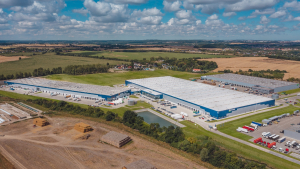
Rising energy prices and construction costs, the volatility and depreciation of the forint against the euro, rising interest rates and tightening financing conditions all represent challenges for the actors over the short term, the Hungarian National Bank (MNB) states in its fresh outlook.
In H1 2022, commercial real estate market trends remained positive overall, but risks increased also at the European level, which ultimately may result in the depreciation of property values. In its September 2022 General Warning issued in connection with the vulnerabilities of the European Union's financial system, the European Systemic Risk Board also highlighted risks related to the commercial real estate markets of the member countries.
By end-June 2022, vacancy rates in the Budapest office market and the industrial-logistics market increased to 9.9% and 6.4%, respectively. These vacancy levels cannot be considered high in historical comparison, but in the office market compared to the 5.6% level of the indicator at the end of 2019, a completely different situation prevails, which deserves special attention.
In the office and logistics segments, the anticipated high volumes of new completions suggest a further rise in vacancy rates. Rising construction material prices and supply problems pose a growing risk in the new completion schedule.
During the first seven months of 2022, the turnover of domestic hotels improved significantly in year-on-year terms; in addition to the return of foreign guests, this was also supported by the low base from 2021, which was still affected by epidemiological restrictions. Due to a large number of ongoing development projects, almost 2,300 new hotel rooms are expected to be completed in 2022 H2, representing 4% of the existing capacity.
In H1 2022, the Hungarian investment market saw a turnover of €0.6 billion, which falls short of the 2021 H1 figure by 7%. A major part of the turnover (47%) was generated by a few high-value transactions and three-quarters of it related to domestic investors. Due to the uncertain economic prospects, investors took a “wait-and-see” position. Nevertheless, ongoing transactions have not been stopped, and thus the negative impact of this hesitation is likely to be felt in the 2023 investment turnover. In H1 2022, the yields did not change significantly, however, looking ahead, market participants anticipate rising yields.
In H1 2022, credit institutions’ project loan portfolio secured by commercial real estate, adjusted for the exchange rate effect, essentially stagnated. At the end-H1, the project loan portfolio participating in the moratorium on payments accounted for just 2% of the outstanding portfolio (this ratio is the highest in the hotel segment, 12%).
The foreign currency ratio of outstanding project loans rose slightly, due to the exhaustion of the financial allocation for FGS Go!, reaching 81% at end-Q2. In H1 2022, banks disbursed a similar volume of project loans as one year ago. The amounts disbursed to the industrial-logistics segments increased more significantly.
According to the MNB’s Lending Survey, commercial real estate loan conditions were tightened in the first half of the year, while looking ahead in net terms a third of the banks anticipated further tightening. Of the respondent institutions, 40% perceived lower demand in the first half of the year, while 58% expect the same in the second half of the year.



